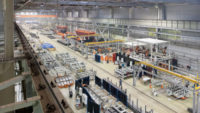In the past several decades, the size of industrial systems and the technology that grows alongside it has, naturally, expanded. Alongside it, though, the hazardous factors that cause major accidents—like unstable conditions and behavior—have become even more complex, thereby expanding in a similar vein at a breakneck speed.
As such, it’s no longer effective to simply try to minimize these industrial risks with conventional approaches, as these risks grow more complex each day. But if conventional approaches are truly no longer viable, what’s the solution to ensure industrial safety?
According to a recent study published on the Elsevier Journal, dramatic steps are needed, with the help of cutting-edge technology, to create technological solutions for safety management by achieving technology convergence throughout a large swath of industries, including machinery, manufacturing, chemistry, construction, and more. Technology convergence occurs when different types of technology exist and co-habitate in a single space to share resources, interact, and create new technology and convenience.
This study was intended to help safety managers and engineers find technology trends that can change industrial safety as we know it, while uncovering relevant trends for reducing hazardous factors and highlighting how technology convergence points toward new, optimized safety and accident prevention measures throughout the industrial workplace.
The results of this study suggest that technology and technology convergence are a dominant trend in industrial safety. The study also showed how technology convergence can play a critical role in mediating safety between safety mangers, those in control towers, and workers in an industrial site—especially when it comes to mitigating risk, preventing accidents, and monitoring safety.
How LDA-based methodology can analyze tech convergence
The conclusions stemming from this study were uncovered by patent information and data that was effectively used for analyzing technology descriptions to discover relationships, patterns, and convergence. Using this information, the researchers behind this study used two techniques to extract patterns and relationships from unstructured data to piece together their conclusions.
The study primarily utilizes latent Dirichlet allocation (LDA), which aims to extract latent topics and main keywords contained in the documents within the research, and network analysis, which is used to monitor change patterns and relations.
Using these techniques, the researchers then used convergence trajectories (created from these analyses) to identify trends and to provide insights about the technology trends in safety fields.
Essentially, researchers used these techniques to mine data and keywords in order to piece together relationships and patterns, then, employing convergence trajectories, they were able to shine a light on the insights these analyses laid out, which effectively uncovers new ways that technology trends have—and will—provide insights on safety in the industrial space.
Through this modeling and methodology, researchers were able to map out six clusters that pertain to various industrial settings and focus on various industrial and safety-based keywords. The resulting findings were based on the convergent patterns and relationships—with linkage strengths that are described as both strong and weak—that developed as a result of the two techniques for analysis.
Key findings of the study & their relevancy in industrial workplaces
So, what exactly were the key findings of this text and data mining project? For starters, the main highlight of this study was that information technology is a dominant trend, and it continues to play a critical role in mediating safety in industrial sites.
Of the trends found within the convergence and mapping of the six clusters, it was found that safety technology convergence has a positive impact on human health and society. Many fields of technology have been related to each other for preventing risks of industry practice. For example, it was determined that sensor-based information technology can be considered a “very opportune” issue in constructing safer systems for workers and can be strongly applied to various industrial sites. It’s noted that the IoT, one of these technological advancements in the industrial setting, has proven to prevent accidents by implementing an automatic process of factory layout.
Consider Siemens, which is a global supplier of manufacturing technology. They’ve concentrated their intelligent manufacturing systems for “high quality and safe manufacturing processes using IoT and CPS.” By constructing these intelligent systems (which were conceptualized through technology convergence), their processes have helped to protect workers, prevent accidents, automate factory layout, mitigate risk, and more.
Overall, the implications of this type of technology convergence can mean a future of faster, more optimized technologies that can be more beneficial than the current conventional approaches to industrial safety. For example, according to the study, in complex safety systems of smart factory or building information systems, managers have “attempted to reduce the faults and accidents through information technology such as the Internet of Things (IoT) and cloud network which is capable of sensing physical signals in real-time and controlling the movement of facilities in advance.”
This means that our conventional methods for safety may need to be fundamentally reassessed, permanently altering the way we go about collecting information that directly affects exposure assessment, risk assessment, and how the industry as a whole creates cost-effective, better solutions for protecting workers’ live and well-being.
This study goes past just pushing a point that technology convergence is a positive trend that should continue to exist within this space—it shines a light on backing these trends and developments, suggesting that the more we lean into this technology, the better we’ll be able to understand and integrate them into our workplaces, extracting greater values from safe, healthy employees and mitigating costs and risks that are associated with hazardous accidents.



